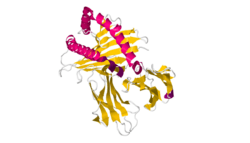Proteolipid protein 1
| View/Edit Human | View/Edit Mouse |
Proteolipid protein 1 (PLP1) is a form of myelin proteolipid protein (PLP). Mutations in PLP1 are associated with Pelizaeus-Merzbacher disease. It is a 4 transmembrane domain protein which is proposed to bind other copies of itself on the extracellular side of the membrane. In a myelin sheath, as the layers of myelin wraps come together, PLP will bind itself and tightly hold the cellular membranes together.
This gene encodes a transmembrane proteolipid protein that is the predominant myelin protein present in the central nervous system (CNS). The encoded protein functions in myelination. This protein may play a role in the compaction, stabilization, and maintenance of myelin sheaths, as well as in oligodendrocyte development and axonal survival. Mutations associated with this gene cause X-linked Pelizaeus-Merzbacher disease and spastic paraplegia type 2. Two transcript variants encoding distinct isoforms have been identified for this gene.[3]
In melanocytic cells PLP1 gene expression may be regulated by MITF.[4]
Interactions
Proteolipid protein 1 has been shown to interact with Myelin basic protein.[5][6]
See also
References
- ↑ "Human PubMed Reference:".
- ↑ "Mouse PubMed Reference:".
- ↑ "Entrez Gene: PLP1 proteolipid protein 1 (Pelizaeus-Merzbacher disease, spastic paraplegia 2, uncomplicated)".
- ↑ Hoek KS, Schlegel NC, Eichhoff OM, et al. (2008). "Novel MITF targets identified using a two-step DNA microarray strategy". Pigment Cell Melanoma Res. 21 (6): 665–76. doi:10.1111/j.1755-148X.2008.00505.x. PMID 19067971.
- ↑ Wood, D D; Vella G J; Moscarello M A (Oct 1984). "Interaction between human myelin basic protein and lipophilin". Neurochem. Res. UNITED STATES. 9 (10): 1523–31. doi:10.1007/BF00964678. ISSN 0364-3190. PMID 6083474.
- ↑ Edwards, A M; Ross N W; Ulmer J B; Braun P E (Jan 1989). "Interaction of myelin basic protein and proteolipid protein". J. Neurosci. Res. UNITED STATES. 22 (1): 97–102. doi:10.1002/jnr.490220113. ISSN 0360-4012. PMID 2467009.
Further reading
- Woodward K, Malcolm S (1999). "Proteolipid protein gene: Pelizaeus-Merzbacher disease in humans and neurodegeneration in mice.". Trends Genet. 15 (4): 125–8. doi:10.1016/S0168-9525(99)01716-3. PMID 10203813.
- Garbern J, Cambi F, Shy M, Kamholz J (1999). "The molecular pathogenesis of Pelizaeus-Merzbacher disease.". Arch. Neurol. 56 (10): 1210–4. doi:10.1001/archneur.56.10.1210. PMID 10520936.
- Yool DA, Edgar JM, Montague P, Malcolm S (2000). "The proteolipid protein gene and myelin disorders in man and animal models.". Hum. Mol. Genet. 9 (6): 987–92. doi:10.1093/hmg/9.6.987. PMID 10767322.
- Hudson LD (2003). "Pelizaeus-Merzbacher disease and spastic paraplegia type 2: two faces of myelin loss from mutations in the same gene.". J. Child Neurol. 18 (9): 616–24. doi:10.1177/08830738030180090801. PMID 14572140.
- Inoue K (2005). "PLP1-related inherited dysmyelinating disorders: Pelizaeus-Merzbacher disease and spastic paraplegia type 2.". Neurogenetics. 6 (1): 1–16. doi:10.1007/s10048-004-0207-y. PMID 15627202.
- Doll R, Natowicz MR, Schiffmann R, Smith FI (1992). "Molecular diagnostics for myelin proteolipid protein gene mutations in Pelizaeus-Merzbacher disease". Am. J. Hum. Genet. 51 (1): 161–9. PMC 1682866
 . PMID 1376966.
. PMID 1376966. - Strautnieks S, Rutland P, Winter RM, et al. (1992). "Pelizaeus-Merzbacher disease: detection of mutations Thr181----Pro and Leu223----Pro in the proteolipid protein gene, and prenatal diagnosis". Am. J. Hum. Genet. 51 (4): 871–8. PMC 1682779
 . PMID 1384324.
. PMID 1384324. - Pratt VM, Trofatter JA, Schinzel A, et al. (1991). "A new mutation in the proteolipid protein (PLP) gene in a German family with Pelizaeus-Merzbacher disease". Am. J. Med. Genet. 38 (1): 136–9. doi:10.1002/ajmg.1320380129. PMID 1707231.
- Weimbs T, Dick T, Stoffel W, Boltshauser E (1991). "A point mutation at the X-chromosomal proteolipid protein locus in Pelizaeus-Merzbacher disease leads to disruption of myelinogenesis". Biol. Chem. Hoppe-Seyler. 371 (12): 1175–83. doi:10.1515/bchm3.1990.371.2.1175. PMID 1708672.
- Popot JL, Pham Dinh D, Dautigny A (1991). "Major Myelin proteolipid: the 4-alpha-helix topology". J. Membr. Biol. 120 (3): 233–46. doi:10.1007/BF01868534. PMID 1711121.
- Pham-Dinh D, Popot JL, Boespflug-Tanguy O, et al. (1991). "Pelizaeus-Merzbacher disease: a valine to phenylalanine point mutation in a putative extracellular loop of myelin proteolipid". Proc. Natl. Acad. Sci. U.S.A. 88 (17): 7562–6. doi:10.1073/pnas.88.17.7562. PMC 52341
 . PMID 1715570.
. PMID 1715570. - Simons R, Alon N, Riordan JR (1987). "Human myelin DM-20 proteolipid protein deletion defined by cDNA sequence". Biochem. Biophys. Res. Commun. 146 (2): 666–71. doi:10.1016/0006-291X(87)90580-8. PMID 2441695.
- Kronquist KE, Crandall BF, Macklin WB, Campagnoni AT (1988). "Expression of myelin proteins in the developing human spinal cord: cloning and sequencing of human proteolipid protein cDNA". J. Neurosci. Res. 18 (3): 395–401. doi:10.1002/jnr.490180303. PMID 2449536.
- Edwards AM, Ross NW, Ulmer JB, Braun PE (1989). "Interaction of myelin basic protein and proteolipid protein". J. Neurosci. Res. 22 (1): 97–102. doi:10.1002/jnr.490220113. PMID 2467009.
- Hudson LD, Puckett C, Berndt J, et al. (1989). "Mutation of the proteolipid protein gene PLP in a human X chromosome-linked myelin disorder". Proc. Natl. Acad. Sci. U.S.A. 86 (20): 8128–31. doi:10.1073/pnas.86.20.8128. PMC 298228
 . PMID 2479017.
. PMID 2479017. - Trofatter JA, Dlouhy SR, DeMyer W, et al. (1990). "Pelizaeus-Merzbacher disease: tight linkage to proteolipid protein gene exon variant". Proc. Natl. Acad. Sci. U.S.A. 86 (23): 9427–30. doi:10.1073/pnas.86.23.9427. PMC 298509
 . PMID 2480601.
. PMID 2480601. - Gencic S, Abuelo D, Ambler M, Hudson LD (1989). "Pelizaeus-Merzbacher disease: an X-linked neurologic disorder of myelin metabolism with a novel mutation in the gene encoding proteolipid protein". Am. J. Hum. Genet. 45 (3): 435–42. PMC 1683421
 . PMID 2773936.
. PMID 2773936. - Mattei MG, Alliel PM, Dautigny A, et al. (1986). "The gene encoding for the major brain proteolipid (PLP) maps on the q-22 band of the human X chromosome". Hum. Genet. 72 (4): 352–3. doi:10.1007/BF00290964. PMID 3457761.
- Diehl HJ, Schaich M, Budzinski RM, Stoffel W (1987). "Individual exons encode the integral membrane domains of human myelin proteolipid protein". Proc. Natl. Acad. Sci. U.S.A. 83 (24): 9807–11. doi:10.1073/pnas.83.24.9807. PMC 387231
 . PMID 3467339.
. PMID 3467339. - Kahan I, Moscarello MA (1986). "The intramembranous domains of lipophilin in phosphatidylcholine vesicles are similar to those in the myelin membrane". Biochim. Biophys. Acta. 862 (1): 223–6. doi:10.1016/0005-2736(86)90487-6. PMID 3768366.
External links
- PLP1 protein, human at the US National Library of Medicine Medical Subject Headings (MeSH)
- GeneReview/NCBI/NIH/UW entry on PLP1-Related Disorders

